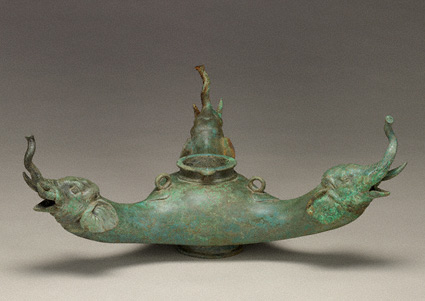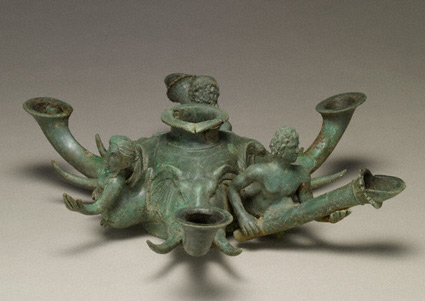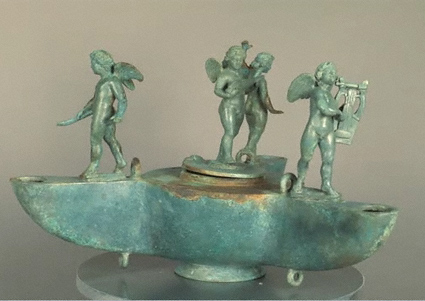| Bronze Lamps from Ancient Vani | |||||||||||||||
|
Four bronze lamps featured in The Golden Graves of Ancient Vani were discovered at Vani in 2007. Their secure archaeological context, as well as their creative use of Hellenistic Greek motifs, make them valuable indicators of activity at Vani during the years before its final destruction around 50 B.C. Two of these four lamps—those adorned with Erotes and with Zeus and Ganymede—were recently conserved by the J. Paul Getty Museum at the Getty Villa in collaboration with the Georgian National Museum.
|
|||||||||||||||
|
Lamp or Incense Burner with Elephant Heads Careful attention was paid to the rendering of the three elephant heads that serve as openings for this lamp or incense burner. The cranial protuberances and small ears identify the animals as Indian elephants. Their arched trunks and open mouths would have appeared all the more dramatic when emitting flames or smoke. The three loops on the upper part were used for suspension. |
Lamp with Elephant Heads and Human Figures The trunks of three Indian elephants swing upward to serve as nozzles for this lamp. In between are truncated human figures. The one wearing a lionskin is probably the hero Herakles, but the other two are at present unidentified. They hold what appear to be torches, which are connected to the lamp's reservoir and would have also functioned as nozzles; this is evident from the cavity in the female figure, who is now missing her torch. The lamp has no loops for suspension and would have been set on a stand. |
||||||||||||||
|
|
||||||||||||||
|
Lamp with Zeus and Ganymede The underside of this three-nozzled lamp features the god Zeus in the form of an eagle, carrying his young love Ganymede off to Mount Olympus to be his cup bearer. The composition is found in many media, but it is particularly effective as an adornment here: when the lamp was lit, the beautiful youth would gleam, and the divine bird would be encircled by a glowing nimbus. In earlier depictions, Zeus is shown pursuing his desire in human form. Credit for representing the god as an eagle flying off with his prize is given to Leochares, an Athenian sculptor of the 300s B.C. |
Lamp with Erotes On the arms of this lamp three reveling Erotes (Greek child gods of love) face outward. One carries a kithara (lyre), another holds a torch, while the third dances. A fourth stands on top of the lid, holding a lute. The hinged lid at the center provides access to a deep reservoir for oil. Rings on the upper surface indicate that the lamp was suspended, while the lower rings suggest that other elements were hung from it. Getty Villa conservators have largely cleaned the bronze of its burial encrustations, leaving some areas untreated to give a sense of the condition before conservation. The treatment will be completed after the exhibition closes. |
||||||||||||||
|
|
||||||||||||||



